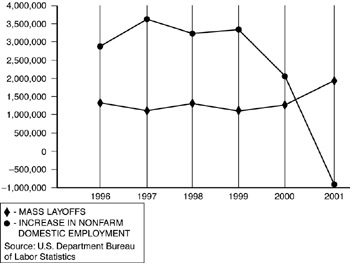Human Capital And Layoffs: Recent History
Between 1996 and 2000 the U.S. economy experienced two important trends, indicating how layoffs have become a natural feature of the economy. (See Figure 1-1.) On one hand employment increased significantly. More than 2.5 million jobs a year were added between 1996 and 2000. At the same time and over the same period, mass layoffs became consistent, averaging more than 1 million in over 5000 companies per year. This combination of job growth and layoffs demonstrates how dependent companies have become on using layoffs as a management tool. Companies in effect were rebuilding “on the go,” responding to growth needs by bringing aboard new talent, and at the same time shedding the skills that were no longer required.

Figure 1-1: Changes in Employment and Layoffs 1996–2001
The recession of 2001 represented a major reversal, or “twist,” in the labor market. Mass layoffs surged from 1.2 million a year to 1.7 million in 2001. Coupled with a steep decrease in new hires, organizations were caught in a bind. Those recently hired with the much-needed cutting-edge skills became the first to be cut: last in, first out. As a result companies saved money and propped up the bottom line but paid a significant price. The very knowledge worker skills that were needed most were lost. Proactive companies have learned from this mistake and are beginning to employ a number of cost-cutting methods prior to, instead of, or in conjunction with layoffs to preserve their mission-critical skills.
EAN: 2147483647
Pages: 143